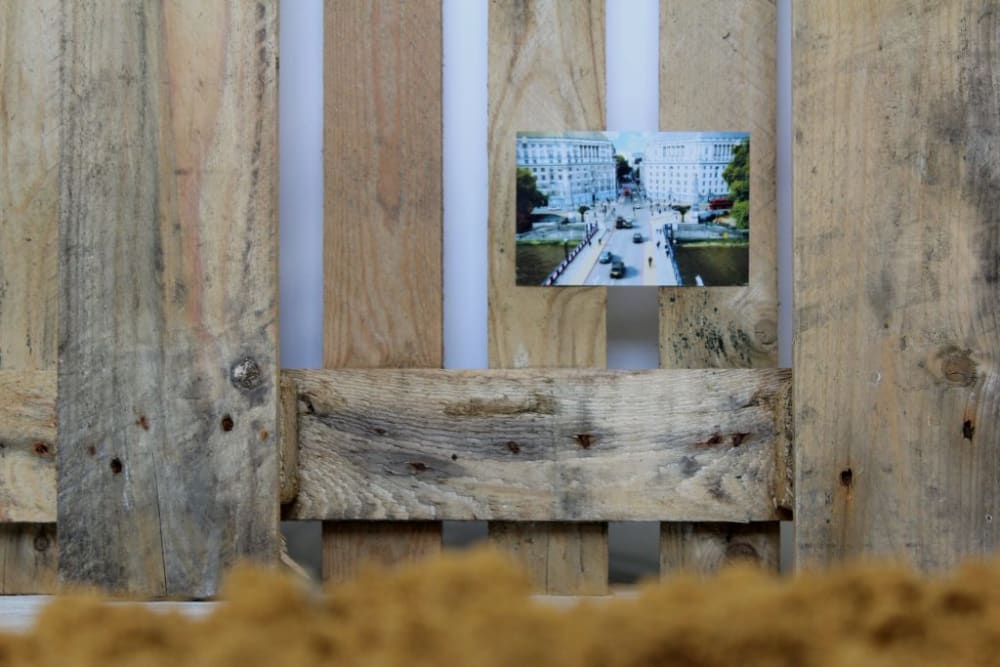In the lead up to the 2018 Undergraduate Summer Show, we interview graduating students about their life at Chelsea and how their learning experience has shaped their practice. Originally from Orpington, Kent, BA Fine Art student Nikitah Patel’s project for the degree show follows the journey of the Phoenix Palm tree on Lambeth Bridge roundabout from its origin to its future relocation.
Describe your time at Chelsea in 3 words
Full of plants
How has your work developed during your time at Chelsea?
My practice has always been concerned with occupation of manmade spaces; in the first year I was looking at the use and reuse of excess building material from homes and construction sites. The work took a turn in the second year, exploring the conflict that has arisen from the interaction between manmade spaces like buildings, and the natural spaces they occupy. Being a part of the studio environment, in which all students are making different kinds of work, nurtured my practice into reaching new ground and new material. I have now developed a particular approach to making work which takes an object as seemingly ordinary as a houseplant and uses it to amplify history, as well as broader themes of nature and mankind, through installation and photography.
What are you working on for the degree show?
For the degree show I am working on a piece titled ‘The Lambeth Phoenix’ – an installation of material relating to the Phoenix Palm tree on the northern Lambeth Bridge roundabout, just along the road from Chelsea. In a proposal currently under consultation, Transport for London (TfL) intend to remove the roundabout and the palm tree in favour of newer, safer cycle lanes. The physical and photographic elements within the work map the trajectory of the palm from its origins in the Canary Islands and the birth of Lambeth Bridge, to its shift as a politicised object in the midst of this consultation and potential relocation in 2019.

In what ways has the studio environment informed your practice during your time at Chelsea?
In the lead up to the degree show I have been photographing the shadows cast by exotic palm trees in outdoor landscapes, as I like the idea that a shadow can act as a trace of an object in time. The photography studios at Chelsea have been an invaluable resource to my practice across my time on the course, to photograph the plants from the indoor greenhouse I set up in the studio, and more recently to recreate the shadows in a controlled environment in order to develop a high resolution image which will form a part of the final work.
What have you enjoyed the most about studying and living in London?
London has a huge and influential art and cultural scene, and I have enjoying studying and living in such close proximity to some of the biggest art institutions in the world and being able to see as many shows as I can during my time at Chelsea, as they have provided huge inspiration to my developing practice.

Who or what has been your biggest influence during your time at Chelsea?
My practice centres on the ecological conflicts between manmade and natural environments, so I spend a lot of time photographing the green landscape around London. The city is vastly populated with trees and plants not naturally grown in our climate, and yet they have become so normalised as street furniture that we don’t think to look beyond their appearance and question their nature. Visiting the huge Victorian glasshouses at Kew Gardens in Richmond has been the biggest inspiration for the direction of my work as Kew is a giant collage of exotic species of plants from all over the world, and a reminder of a time when such plants were revered for being a symbol of a powerful global Empire.
What makes your proud to be a Chelsea student?
I am proud to be a part of something that feels like a strong community of people. The strength of the studio environment we have developed during our time here – the support and drive of the students on the course – will be something I hope never to lose.

What would you say to anyone thinking of doing your course? Any advice for new students?
The course at Chelsea gives room for you to structure it the way that is most useful to you and your practice. Use this flexibility in time to challenge yourself, test out new materials in the workshops, take part in offsite exhibitions and visit as many shows as you can. Allow your practice to grow and evolve, because this is the time to make work on your own terms.
Click here to find out more about BA Fine Art
For information on the Undergraduate Summer Show opening on 15 June – 23 June, click here
To see more work from our graduating students, head to chelseadegreeshow.com

